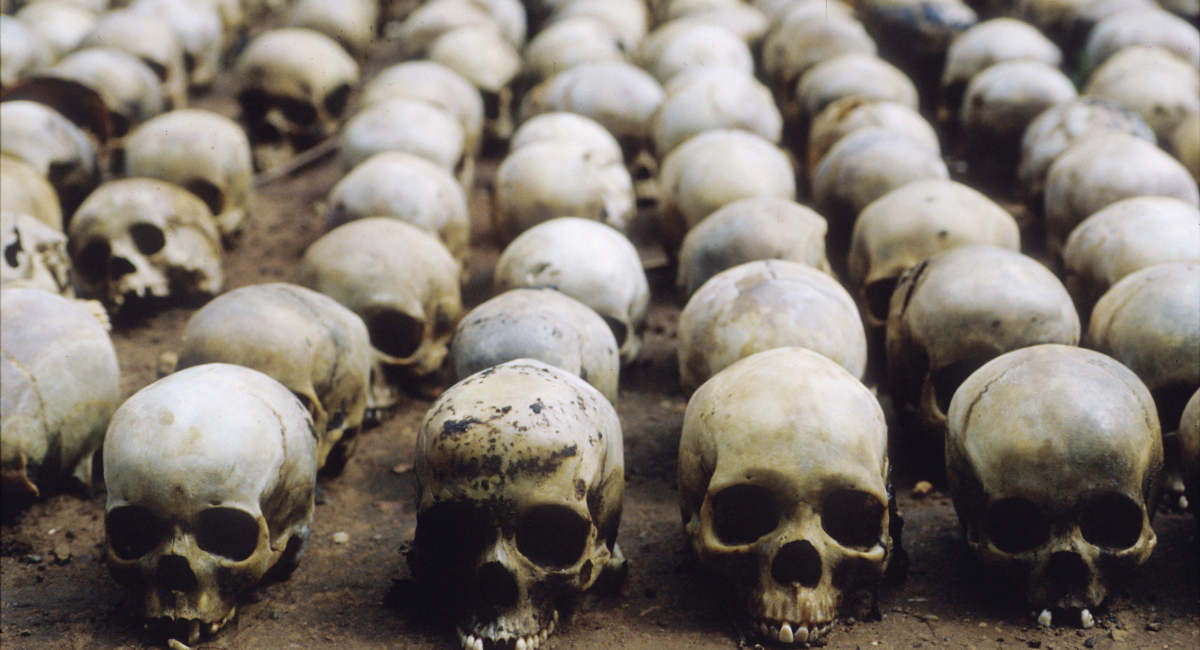WARNING: This article contains disturbing images.
Live Action and Live Action News recently released photo imagery of abortion victims — babies who appear to have been killed late in pregnancy, reportedly connected to the Washington Surgi-Clinic abortion facility after being discovered by pro-life activists in Washington, D.C. The photos have set off a firestorm of controversy, with reactions ranging from support and praise to criticism and hate.
But one fact related to all of this is indisputable: using photojournalism to expose human atrocities is not new, and it is important.
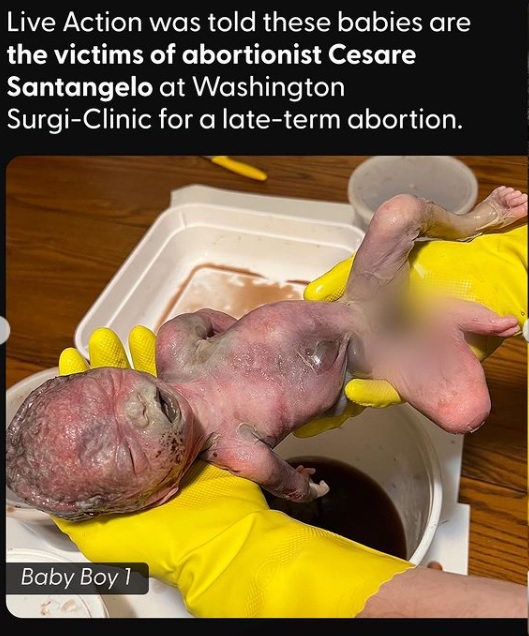
Aborted babies found in DC – Baby Boy 1, a.k.a. “Christopher X”
Sudan
In 2005, New York Times journalist Nicholas D. Kristof reviewed horrific images of murders allegedly conducted by Sudanese government-backed militia. He graphically described multiple victims in a New York Times article, “The Secret Genocide Archive”:
This African Union archive is classified, but it was shared with me by someone who believes that Americans will be stirred if they can see the consequences of their complacency. The photo at the upper left was taken in the village of Hamada on Jan. 15, right after a Sudanese government-backed militia, the janjaweed, attacked it and killed 107 people. One of them was this little boy. I’m not showing the photo of his older brother, about 5 years old, who lay beside him because the brother had been beaten so badly that nothing was left of his face. And alongside the two boys was the corpse of their mother.
One wrenching photo in the archive shows the manacled hands of a teenager from the girls’ school in Suleia who was burned alive. It’s been common for the Sudanese militias to gang-rape teenage girls and then mutilate or kill them. It’s worth being skeptical of any document because forgeries are possible. But the African Union believes this document to be authentic.
Rwanda
In 2014, National Geographic honored a Pulitzer prize nominee and journalist who documented the Rwandan Genocide.
“The nonchalance of death was astonishing. And I cannot get that out of my mind. To this day, I don’t understand it. But I left a little bit of my soul there somewhere,” photographer Jean-Marc Bouju told NATGEO.
“The massacres, mostly by gangs wielding machetes, swept across Rwanda and groups of people were killed in their homes and farms and where they sought shelter in churches and schools,” one image captured at USA Today reads. Another photo, which shows an orphan, his legs amputated below the knee, is captioned, “The scale of the killings in 1994 was unimaginable but the reporting and photographs taken at the time helped to inform the world of the horrors of the genocide.”
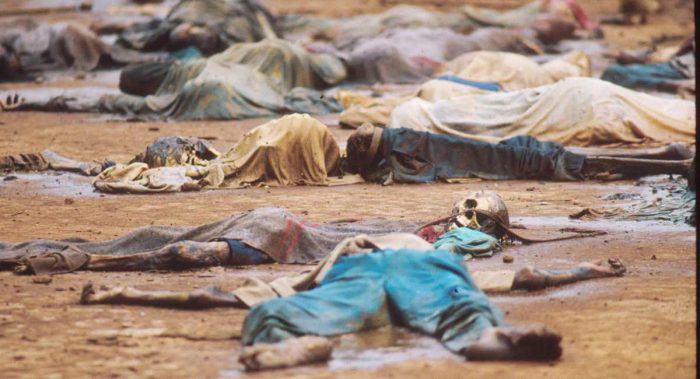
359329 08:Tutsi victims of a Hutu massacre lie outside the Rukara Catholic mission in Rukara, Rwanda May 12, 1994. One of the worst single massacre sites of the Rwandan genocide, Rukara saw 800 people die inside and around the church. (Photo by Scott Peterson/Liaison)
Earlier this month, Human Rights Watch went public to claim, “Judicial authorities in Rwanda are prosecuting opposition members, journalists, and commentators on the basis of their speech and opinions.” Human Rights Watch also stated online, “Rwandan authorities have threatened, arrested, or prosecuted at least eight people reporting or commenting on current affairs on YouTube over the past year,” adding,”While it is positive that none of the cases have resulted in convictions, the threat and fear of prosecution for reporting on sensitive issues has a persistent chilling effect.”
“Rwanda’s narrow definition of journalists as ‘a person who possesses basic journalism skills and who exercises journalism as his/her first profession’ runs counter to international standards and has allowed the state to prosecute bloggers doing important public interest reporting on the government’s response to Covid-19,” Human Rights Watch noted.
Apartheid
“Ernest Cole, South Africa’s first black photojournalist, challenged the power structures of apartheid South Africa in his attempt to reveal knowledge and construct social reality through his photographs,” writes LesnCulture.com.
In praising his work, the article, “Looking at Power: The Relevance of Apartheid Photography Today,” read in part, “Indeed, throughout apartheid, the government feared photography—so much so that it eventually banned foreign journalists. Documentary photography was illegal, and so Cole’s work became contraband. By telling the story of apartheid, Cole confronted power structures that otherwise controlled this geographic and political region.”
Ukraine
Recently, Time Magazine highlighted the work of Ukrainian photographer Maxim Dondyuk. “When we show them the children killed by Russian bombs, they will imagine their own children. Our children are the same. Our cities look the same. They will see themselves in us. They will feel it,” Time quoted Dondyuk as saying.
Ukrainian journalist and writer, Stanislav Aseyev, uploaded a horrific video to Twitter of dead civilians allegedly killed by the Russian army. “Maria Genkin: Pictures of some villages freed in Kyiv region, specifically Bucha, are devastating. Dead people lying outside of their houses, in what can only have been a ‘zachistka’ – systemic execution of the men of each house. One body in front of every house,” he tweeted, adding in the thread, “Russians practiced this in Chechnya. Also pictures of men with tied hands and killed execution style in small groups. When Soviets were overtaken by Germans in 1941, they have left behind prisons full of man executed in such a way.”
The was retweeted by Jodi Jacobson, a staunch pro-abortion activist and former editor for RewireNews, who wrote, “Mass graves. Children tortured. Bodies strewn through the streets. Shame on us for not doing more to prevent this. President Zelenskyy literally *begged* for planes and tanks we could have provided, and we did nothing but make lame excuses.”
Exposing the atrocities of abortion
While not comparing one atrocity against another, it is in this spirit that pro-life activists have stepped into the world of photojournalism and investigation to expose what is hidden behind the walls of legal abortion facilities inside the United States.
Monica Migliorino Miller, founder of Citizens for a Pro-Life Society, is an activist who has made it her mission to expose the horrors of the abortion industry by photographing the graphic truth about abortion, as noted in a previous Live Action News report. Over a 30-year period, Miller has retrieved thousands of aborted babies from trash receptacles and photographed their remains to record the injustices perpetrated against these vulnerable human beings.
In 1982, approximately 17,000 babies were found in a repossessed storage container in Los Angeles. The babies, many of whom were more 20 weeks gestation, were stored by a medical lab which received aborted babies from several states…The gruesome effort of documenting the death of each child was captured by a photographer who said that he saw babies with “eyes bulging and some where the chest cavity was ripped open….” Read more about this grisly story and others like it at Live Action News here.
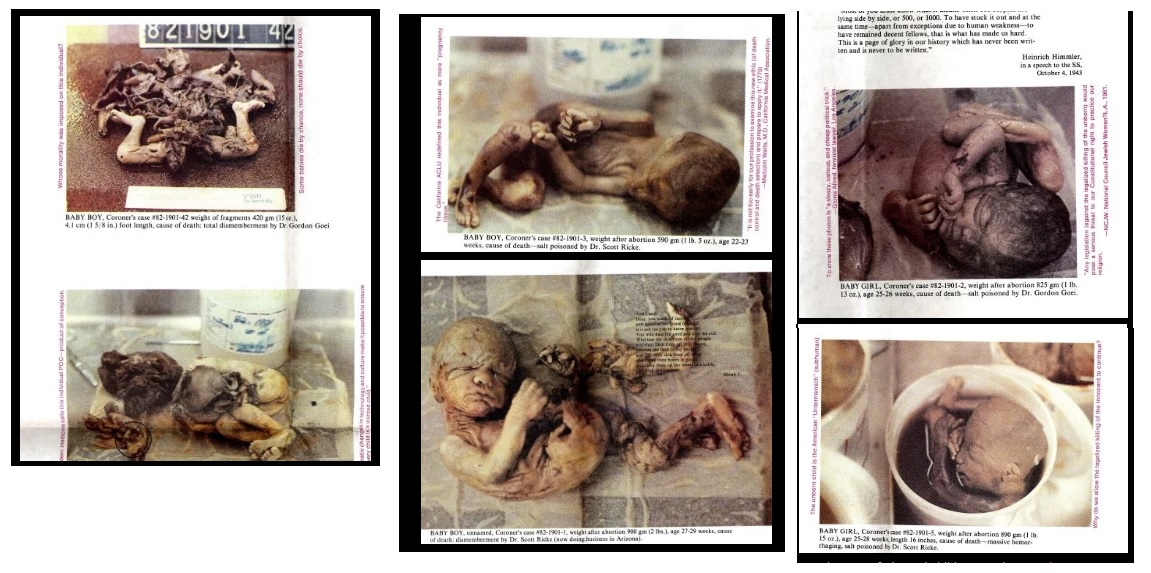
Image: American Holocaust – aborted babies found in storage container
In 1986, a pro-life group claimed they found third trimester aborted babies outside an abortion facility in Houston, Texas. “His umbilical cord was ripped from his body, which also detached his penis… Both the child’s buttocks were carved off,” a pamphlet describing the baby read in part.
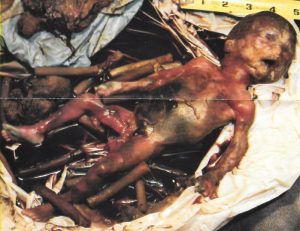
Third trimester aborted babies found in Houston 2
Abortion facility staffers from a Texas abortion facility spoke to the anti-abortion group Life Dynamics to expose babies allegedly being aborted alive. In the video, the former workers claimed the abortionist was “twisting the head off the neck,” stabbing instruments into babies’ stomachs or the “soft spots” of the babies’ heads, inserting his finger through babies’ throats, and severing their spinal cords. They claimed they witnessed the abortionist killing preborn babies late in pregnancy and accused him of killing babies born alive.
As evidence, the workers provided photos (see below) to Operation Rescue. A grand jury refused to indict the abortionist in that case.
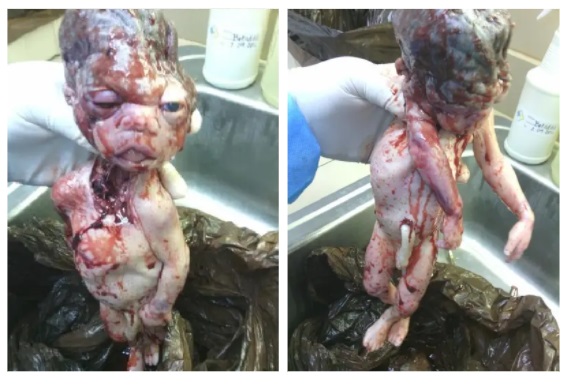
Aborted baby images to Operation Rescue from staff at Houston abortion facility operated by Douglas Karpen
“The Washington, D.C. police department and the District’s medical examiner must conduct a thorough forensic medical examination of five dead children discovered outside a D.C. abortion clinic, to determine their manner of death. Anything less is a dereliction of their duty,” said Live Action founder and president Lila Rose in an April 2 press release. “Conducting autopsies for these children is the absolute minimum required to ensure that federal and state laws were not violated in their deaths.” Rose and others are calling for #JusticeForTheFive on social media.
“Like” Live Action News on Facebook for more pro-life news and commentary!

